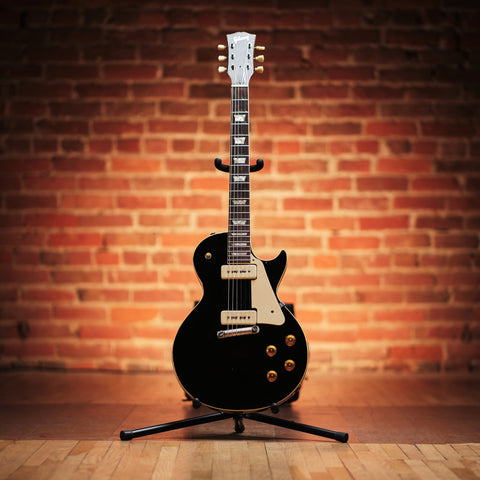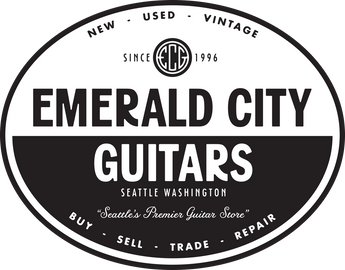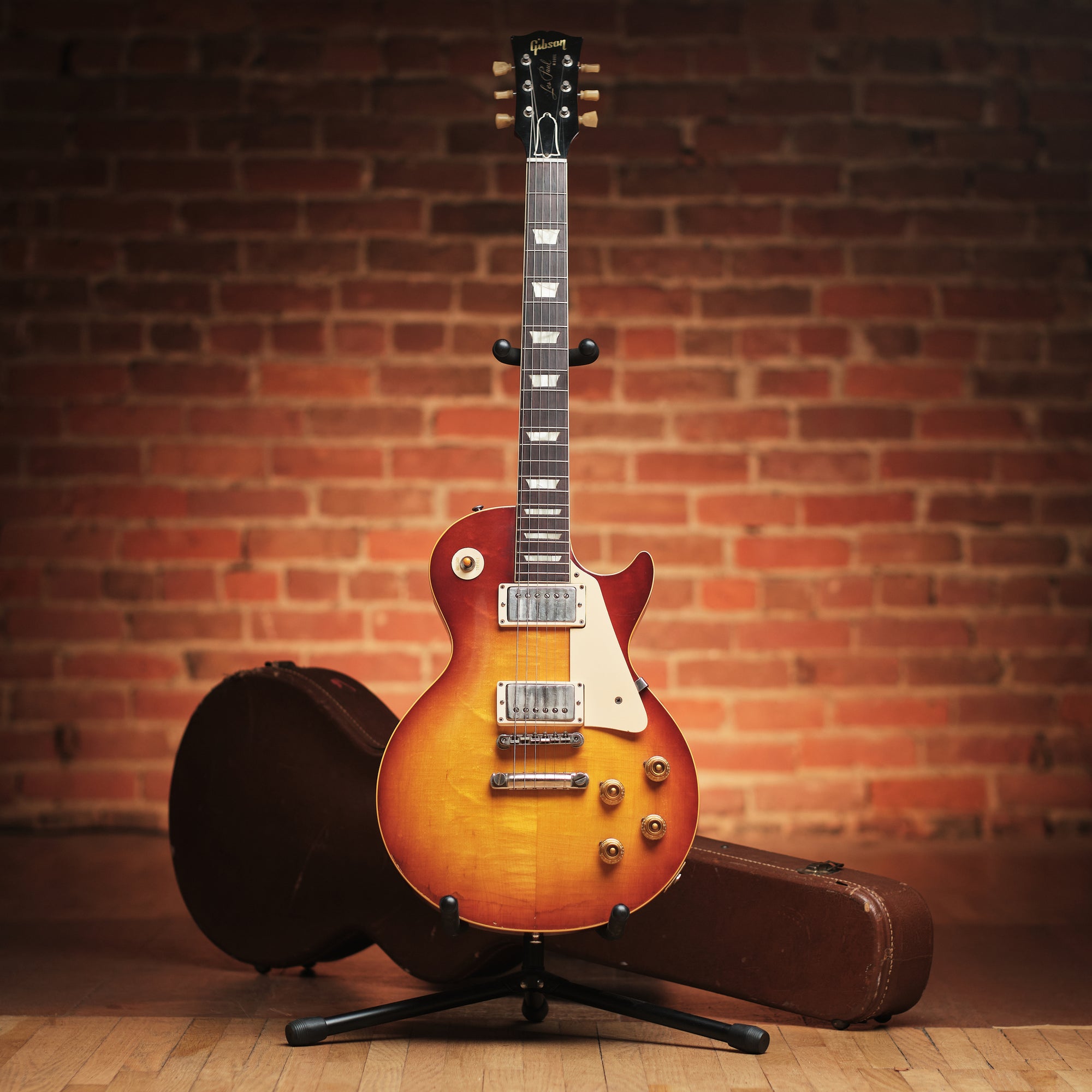1966 Fender Stratocaster

People often ask us our opinions on how to safely navigate the inevitable ups and downs of the vintage guitar market. While nothing in life is 100% sure, we always give them a similar answer: buy an iconic model that is original as possible and as clean as possible, and you will almost certainly make money. This particular Strat happens to be a perfect example of the kind of guitar we’re talking about.

This 1966 model is 100% original and about as clean as we’ve ever seen. This is likely due in part to the previous owners’ religious use of a “Body Guard.” This was a Fender invention of the 60s, a clear molded plastic shell that slid onto the back of the instrument to mitigate any rear end damage. Ironically, these musical prophylactics typically reacted poorly with the guitar’s finish, and caused much more harm than good. By some miracle, this Strat was able to avoid this fate, and remains virtually like-new. 1966 was a unique year of transition for the model, moving forward towards the 70s with features like the large headstock, but remaining thoroughly pre-CBS in terms tone and craftsmanship. This one even has a December ’65 neck date along with a number of earlier features that make this example even more special. Truly a museum-quality piece, I can’t imagine a finer example of a ’66 Strat being unearthed without the use of a time machine.
1952 Gibson Les Paul ’52/’54 Conversion

What can I say about Les Paul conversions that I haven’t already said? (Check our March 24th newsletter for my thoughts on a recently-sold ’52/’57) If you’re reading this, there’s a good chance you may share my opinion that vintage guitars are among the coolest things on Earth. One of the least cool things, you ask? Going out of your way to try to be something you’re not.
So when the stripped carcass of this early ’52 found its way into my shop, aftermarket belly cut and all, there was a decision to be made. I could inlay matching mahogany into the contour of the back, touch up the color and glue joint as best as I can, track down an original wrap-under trapeze tailpiece, and refinish the guitar as a dark back Goldtop. Or, I could embrace the heresy of our forefathers and take the guitar in an entirely different direction. By my estimation, the first option would leave us with what very well could be the most loathesome Goldtop in existence, and the second option would leave us with literally the coolest ’52 we could possibly imagine.

The first order of business was to remove the neck in order to reset the angle. This was arduous beyond explanation and I recommend it to no one. I chose to kick back the stock 1 degree neck angle to 4 degrees, my ideal geometry for a wraparound tailpiece. Why not go with a stoptail and Tune-o-matic? Because I feel that the wraparound combined with vintage Gibson P-90s is the most underutilized and underappreciated configuration out there. With the playability sorted we were onto the aesthetic considerations. The Strat-esque belly and leg contours on the back had to stay, of course. After a little refinement, it could be argued that this should have been a factory feature. The plan for the finish was decided early on. Black with cream trim is a combination that never looks bad. Duo Jets, Tele Customs, those Esteban infomercial guitars, all are conservative but exude class. Once it all came together, the result was better than any of us could have imagined. A one-of-a-kind player’s ’52 that isn’t ashamed of its storied past.
1977 Fender Starcaster

I think it’s fair to say that the late 70s were nobody’s favorite era of Fender guitars. In the midst of 3-bolt necks and inch-thick poly, though, a bright spot emerged in 1976 with their introduction of the Starcaster. It was a clear departure from the company’s previous business plan: desert the solid body and single coils for a hollow-body, humbucker-equipped instrument. This wasn’t the first time Fender designed a model with the aim to take a bite out of Gibson’s market share, but it sure was the most audacious to date.
At the core of this new model was a pair of Fender’s unique “Wide Range” humbuckers, perhaps the most alluring aspect of the Starcaster. The legendary engineer Seth Lover is famous for inventing the Gibson humbucker in 1955. He’s less famous but equally responsible for inventing the Fender Wide Range humbucker in 1971. If there was a Mount Rushmore of guitar pickup designers, Seth Lover would be on it twice. Despite abandoning single-coil construction, the WRHB is a distinctly Fender pickup. Larger coils slightly altered the classic humbucker sound, but the very unusual use of CuNiFe (copper, nickel, iron) magnets rather than the industry-standard AlNiCo (aluminum, nickel, cobalt) completely transformed the tone of the pickup into something entirely singular. If you ever find standard Gibson humbuckers to be too muddy, boomy, or lethargic, I can guarantee you that the WRHB will be right up your alley. By the time the WRHB was discontinued in 1979, CuNiFe magnets were obsolete in the marketplace, and remained virtually impossible for pickup manufacturers to find until the early 2010s. While several faithful replicas are being built today, nothing quite measures up to the real thing.
1967 Fender Telecaster

When you think of iconic years for the Telecaster, the late 60s might not immediately spring to mind. But in the early years of CBS’ tenure, quality could still be found and this Tele is a great example of that. The most notable feature of this guitar may be the original custom color black finish, uncommon for later 60s Fenders. This particular finish has aged with exceptional grace, exhibiting some light honest play wear and a beautiful pattern of lacquer checking.
This Tele was custom ordered with a maple fretboard, an option first introduced in 1967 and offered at a 5% upcharge. The aesthetic theme of the guitar is distinctly unusual for the era, and from a distance could be mistaken for a custom color Tele from Fender’s first run of maple fretboards from ’50-’59. So whether you’re trying to channel Bob Dylan from his days with The Band, or just looking for a solid investment in Fender history, this one will be hard to pass up.
1914 Martin 0-30

The progression of guitar design, like most vocations, has been largely evolutionary rather than revolutionary. However, the transition from gut to steel strings in Martin’s lineup through the late 1920s represents a landmark divide in the instrument as we know it. The steel string era is responsible for the two heavy hitters that dominate the market to this day: the OM and the Dreadnought, both introduced within a few years of steel becoming the norm.
The common appointment styles like 18, 28, 42, and 45 are still the standard to this day. The gut string era, though, can seem quite foreign to the casual observer. The unfamiliar body sizes, styles, materials, and construction techniques are so distinct from the steel-string Martins we’re accustomed to, you could be forgiven for failing to identify one as a Martin at all. The style 30 had a relatively short run from 1898-1921, but it spent its tenure near the top of the Martin line. Only 356 instruments were ever made in the 30 style, 162 of those being 0-30s. While our steel-string sensibilities may lead us to look down upon the smaller dimensions of the 0, the reality is that the model’s size perfect for the lower tension of gut strings. The now-iconic 000 was very nearly discontinued before the advent of steel strings because of its substandard tone. Early gut-string versions of the Dreadnought were so bad that Martin refused to build them under their own name for almost 20 years. As strange as it sounds, the 0 is arguably the largest effective gut-string guitar out there, and this is a tremendous example. The quality of the old-growth red spruce top (some folks call this Adirondack) is untouchable by anything available today, commercially or otherwise. The Spanish cedar neck is lighter and more reactive than a modern mahogany equivalent. The straight-grain Brazilian rosewood used for the back and sides absolutely puts to shame the all-too-common stump wood sets that flood the modern market. Don’t get spooked because this isn’t a 000, it is likely the best fingerstyle guitar you’ll find in our shop, or any shop for that matter.



